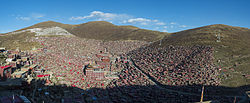| Palpung Monastery | |
|---|---|
 View of Palpung Monastery in 2014 | |
| Religion | |
| Affiliation | Tibetan Buddhism |
| Sect | Karma Kagyu |
| Location | |
| Location | Babang, Dêgê County, Garzê Tibetan Autonomous Prefecture, Sichuan, China |
| Country | China |
| Coordinates | 31°38′54″N98°47′45″E / 31.64833°N 98.79583°E |
| Architecture | |
| Founder | 8th Tai Situ |
| Established | 1727 |
| Protected 1958. Reopened as monastery in 1982. | |

Palpung Monastery (Tibetan : དཔལ་སྤུངས།, Wylie : dpal spungs dgon pa [1] ) is Tai Situ's historic monastic seat in Babang, Kham (modern Sichuan). Palpung means "glorious union of study and practice". It originated in the 12th century and wielded considerable religious, political, and economic influence over the centuries. [2]
Contents
- History
- Palpung in Tibet
- Palpung in India
- Palpung Congregation
- See also
- References
- Sources
- External links
The current monastery was founded in 1727 [3] [4] by the 8th Tai Situ "Situ Panchen" with the great support of the Dharma King of Derge Temba Tsering. It is the seat of four lines of incarnate lamas, the best-known being the Tai Situ [5] as well as the Jamgon Kongtrul and the Second Beru Khyentse. The gompa has historically been associated with the Karmapas: for instance, Rangjung Rigpe Dorje, 16th Karmapa, was enthroned first at Palpung before traveling to his main seat at Tsurphu Monastery in Ü-Tsang.
The 12th Tai Situ, Pema Tönyö Nyinje, has established another monastic seat in exile at Palpung Sherab Ling Monastery (Wylie : dpal spungs shes rab gling in India's state of Himachal Pradesh near the city of Baijnath. Palpung Yeshe Rabgye Ling Nunnery is nearby in the city of Manali, in the town Bunthar about a 3 hour drive from the Palpung Sherab Ling Monastery. [6] ).



